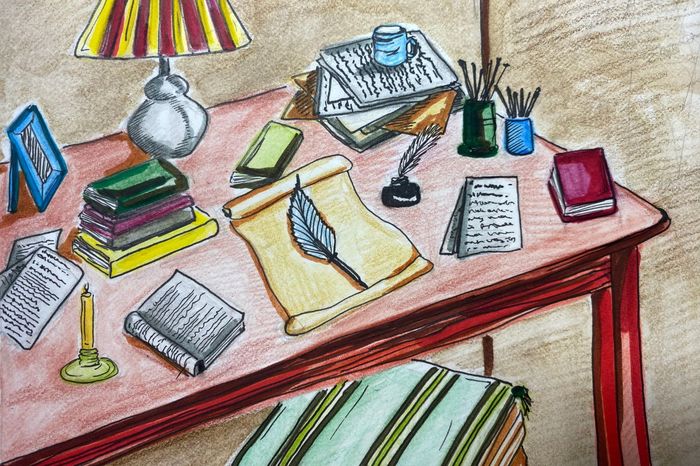A guide to Cambridge’s coat of arms
Ryan Vowles unlocks the meaning behind Cambridge’s most obscure symbols

I hurry to my lectures, on those days when I make it out of bed, under arches of roses and portcullises. I go beneath friezes of painted plaster: horned goats, forget-me-nots, patterned shields. Further down the street I might notice the fleur-de-lis cluttered on Trinity, the snakes of Caius, the University banner in the wind above the old schools. Black coats embroidered with the wheel of Catz or the Downing griffon flash past me. Overwhelmed, I look up at King’s Chapel only to find more portcullises and more roses! With distinct coats of arms, motifs, and colours associated with each college, there’s a lot of symbolism to take in – and the colleges are only the tip of Cambridge’s heraldic iceberg.
Let’s start with the crucial definitions. The shield-shaped part is an escutcheon, which is often displayed alone. The word ‘crest’, which is often misused, is above the shield but is not the shield. You might have supporters on either side or a motto underneath, and the whole thing together is an achievement. You might often hear people talk about their ‘family crest’, which is a double misnomer. Coats of arms do not represent families or groups. A coat of arms belongs to one person (or town or college). When his father dies, a son might inherit his father’s coat of arms, but at any given time it represents only one person.
“This is a description of the design, written in a cryptic mix of old-French and English, which acts as the instructions for artists, carpenters, and, I’m sure, Ryder and Amie’s”
Once Arms have been designed, they are finally given a blazon – the deepest level of obscurity. This is a description of the design, written in a cryptic mix of old-French and English, which acts as the instructions for artists, carpenters, and, I’m sure, Ryder and Amie’s. As an example, the University arms’ blazon is as follows: gules [which means a red background], on a cross ermine [on top, a cross that is white with black marks] between four lions passant guardant [the lions are side on and looking at us] or [and are gold], a Bible lying fesseways of the field, clasped and garnished of the third, the clasps in base [a horizontal bible].
In this case, the lions stand for the royal ties of the University. The ermine signifies dignity, as does the gold, and the Bible and cross denote knowledge and faith. From a single blazon, artists can produce shields and arms to many styles or preferences – for example, they can draw the Bible however they like.
“In this university, more than in most places, heraldry maintains some relevance”
Though heraldry emerged in the Middle Ages, new arms are still granted to institutions and notable people. When he was knighted, The Beatles’ producer, George Martin, chose a blue coat of arms, with a guitar-like cross band and three golden beetles. He even went so far as to have a martin (the bird) as his crest. There’s a long tradition of these canting arms, where the whole thing is a visual pun. The late Queen Mother’s family Bowes-Lyon have a coat of arms of bows and lions; Berlin’s is a bear, which works better with the German pronunciation; and it is perhaps too easy to imagine the blazon of Edwin Forrest.
Why is the term crest so often misused, and why is it associated with families? Often, the crest or some other part of the design was taken as a badge, which might stand for an individual or, often, a family. Richard II took as his badge a White Hart (stag); the Tudors used the Tudor Rose. Badges came to adorn palaces, cathedrals, town centres, and pubs. This is the origin of Cambridge’s many roses and portcullises. Lady Margaret Beaufort was founder of Christ’s and John’s and the mother of Henry VII, who oversaw much of the construction of King’s Chapel. Her badges, inherited from her family, were the portcullis and rose, which now adorn many of the city’s most prominent buildings. Even Westminster Palace, the seat of Parliament, is covered with her badges, as it was once her son’s home – the portcullis now being the symbol of Parliament.
In this University, more than in most places, heraldry maintains some relevance. How many of us wear puffer jackets, hats, and ties decorated with coats of arms? Colleges, sports clubs, societies from beekeeping to med socs, all take designs from heraldry. Although many society logos are ridiculous bastardisations of coats of arms, we see in canting arms a precedent for playfulness and humour. We’re so immersed in heraldic imagery in a place like this – it is easily taken for granted and easily tuned out. Feeling a connection – dare I say a loyalty – to a coat of arms is an unusual thing in the modern world, but whether we like it or not, these coats of arms continue to shape the identity of the places in which we work and live.
Want to share your thoughts on this article? Send us a letter to letters@varsity.co.uk or by using this form.
 News / Caius mourns its tree-mendous loss23 December 2025
News / Caius mourns its tree-mendous loss23 December 2025 News / Cambridge welcomes UK rejoining the Erasmus scheme20 December 2025
News / Cambridge welcomes UK rejoining the Erasmus scheme20 December 2025 News / CUP announces funding scheme for under-represented academics19 December 2025
News / CUP announces funding scheme for under-represented academics19 December 2025 News / King appoints Peterhouse chaplain to Westminster Abbey22 December 2025
News / King appoints Peterhouse chaplain to Westminster Abbey22 December 2025 Interviews / Politics, your own way: Tilly Middlehurst on speaking out21 December 2025
Interviews / Politics, your own way: Tilly Middlehurst on speaking out21 December 2025









